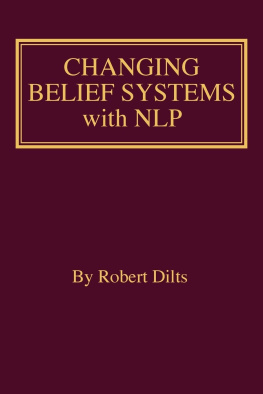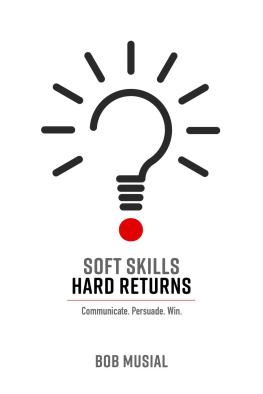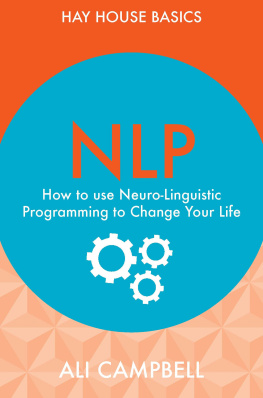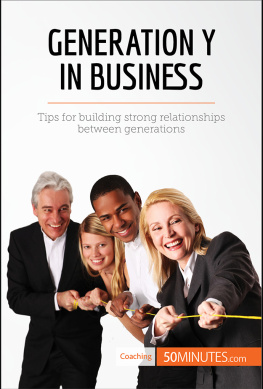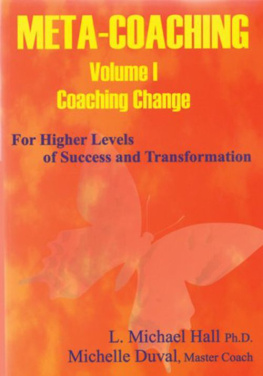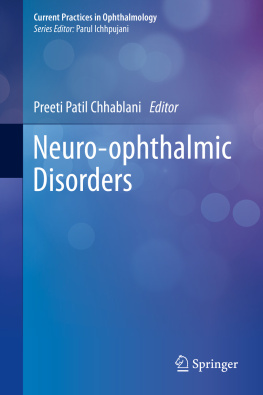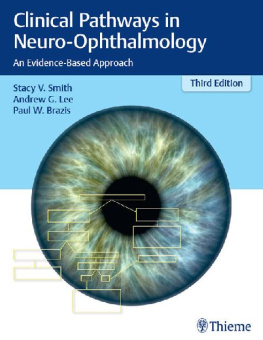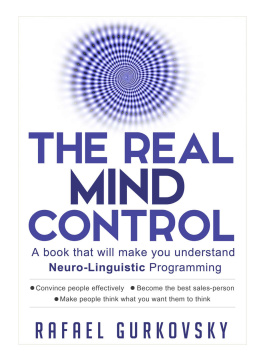

Dilts Strategy Group
P.O. Box 67448
Scotts Valley, California 95067
Phone: +1(831) 438-8314
E-Mail:
Homepage: http://www.diltsstrategygroup.com
Copyright 2010 by Robert B.Dilts and Dilts Strategy Group. All rights reserved. This book or parts thereof may not be reproduced in any form without written permission of the Publisher.
Library of Congress Card Number 2010922378
I.S.B.N. 978-1-947629-17-2
I.S.B.N. 978-1-947629-33-2 (e-book)
Contents
Dedication
This book is dedicated with affection and respect to:
The co-founders of NLP
Richard Bandler and John Grinder
who initiated us into this great adventure and encouraged us to be confident, courageous and creative in our own exploration of the structure of subjective experience.
The creative spirit of
Milton H. Erickson
Virginia Satir
Fritz Perls and
Gregory Bateson
who taught us through their example how to be pioneers of human potential.
The legions of
NLP Practitioners,
Master Practitioners and
Trainers
throughout the world
who have created the fertile and generative field that has made new generations of NLP possible.
Acknowledgments
We would like to acknowledge:
Stephen Gilligan for his profoundly important contributions to the evolution of Next Generation NLP. Stephen was one of the members of the original group of students studying with Richard Bandler and John Grinder at the beginnings of NLP. He has since gone on to develop his own ideas through his work on Self-Relations and the Generative Self.
A number of the core ideas presented in this book regarding generativity, the three minds (cognitive, somatic and field) and their associated principles and elements, archetypal energies, centering and the idea of sponsorship were originally developed by Stephen in his seminal work on Self-Relations (1997). The rich cross-fertilization between Self-Relations and NLP can be seen the book The Hero's Journey: A Voyage of Self-Discovery (Gilligan and Dilts, 2009).
We also want to acknowledge:
Gabrielle Roth, creator of the 5Rhythms (who shares a common mentorship with Gregory Bateson), for continuing to champion the deep importance of movement and connection with the body as key to the process of change.
Richard Moss for making the transformative power of awareness, presence and connection so clear.
Teresa Epstein for working so diligently over the years to provide the NLP University context in which we can all continue to generatively collaborate.
Sandra Bacon for lending her expert proofreading skills to this effort.
Michael Dilts and Claire Sage for their steady support and editing assistance with the cover.
Preface
At the conclusion of our book NLP Volume I (1980), we authors (Dilts, Grinder, Bandler and DeLozier) promised a second volume, NLP II , which would present more concrete applications of the concepts, principles and distinctions we laid out in that first introduction to NLP. We claimed the second book would explore more specifically how to apply Neuro-Linguistic Programming to your work and everyday life.
For a variety of reasons, NLP Volume II never materialized. This was partly because we authors all had busy lives and were intensely involved in developing and experiencing those applications about which we had pledged to write. As time went on, life took us in separate directions. We have never all been together again in the same way as we were in those early days, and the project to produce NLP II got lost in the shuffle.
Another factor was that the field kept developing so rapidly that it was difficult to select a particular group of processes that we felt most characterized the history and potential of NLP. New challenges and opportunities stretched us to find resources and solutions that constantly brought innovations touching the very foundations of the field.
While all four of us original authors of NLP I have continued to travel extensively throughout the world, teaching NLP and contributing to its evolution and development, we (Robert and Judith) have maintained a close personal and working relationship, culminating each year in our summer residential programs at NLP University at the University of California in Santa Cruz.
Over the years, we have frequently ruminated on the vision and promise of an NLP II made all those years ago. People within the field have also continued to ask, Where is NLP Volume II ? At times, we have attempted to fulfill the promise in other ways. We spent four years writing the Encyclopedia of Systemic NLP and NLP New Coding to cover the rich variety of NLP models and applications and to honor the intellectual history of the fascinating field of NLP. In our work, we have sought to preserve the spirit of the original ensemble of students studying and developing NLP in small groups in the Santa Cruz mountains with Bandler and Grinder.
Four years ago, we decided the time had come to finally complete our commitment to a second volume. In our view, there was clearly something new to say. This book NLP II: The Next Generation is a result of that decision.
The book has gone through various evolutions over the past several years and would not exist without the energy and support of Deboraha 5Rhythms dance teacher, psychotherapist and Psychosynthesis trainer as well as an interpreterwho has been an important contributor to a number of the new developments presented in the later chapters.
Deborahs connection with NLP began in 1994 when she interpreted John Grinder into French in Paris, where she has been living since the early 1980s as an American expatriate. Since that time, she has interpreted many other NLP trainers, including David Gordon, Charles Faulkner, Lynne Conwell, Robert McDonald and, of course, Robert and Judith.
Since 2005, Deborah and Robert have been developing programs bringing together Deborahs background in body-oriented transformational practices, such as the 5Rhythms , and principles of NLP. (Robert and Deborah were married in 2008.) They have applied these new developments in workshops and seminars throughout the world as well as with Judith at NLP University in California.
The collaboration between the three of us (Robert, Judith and Deborah) has been characterized by enthusiasm, creativity and inclusiveness. We hope that all these qualities come forth in this book and provide you readers with a new appreciation of the depth, richness and potential of NLP.
Robert Dilts
Judith DeLozier
Deborah Bacon Dilts
August, 2010
Santa Cruz, California
A New Generation of NLP
Background and Overview of NLP
This book is about significant new developments in Neuro-Linguistic Programming. Neuro-Linguistic Programming (NLP ) is an approach to understanding human behavior, and a set of explicit skills and techniques derived from that approach. Originated by Richard Bandler and John Grinder in the 1970s, NLP examines the patterns or programming created by the interaction between the nervous system (neuro ) and language structures (linguistic ), and their influence on our bodies and behaviors. From the NLP perspective, it is this interaction that produces both effective and ineffective behavior, and is responsible for the processes behind both human excellence and pathology.
Next page

